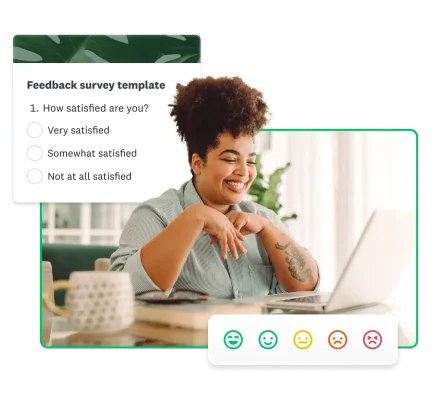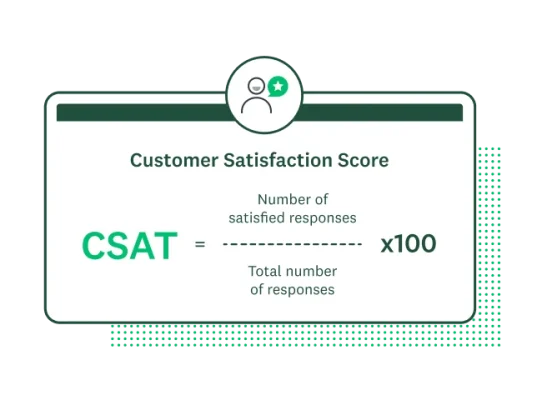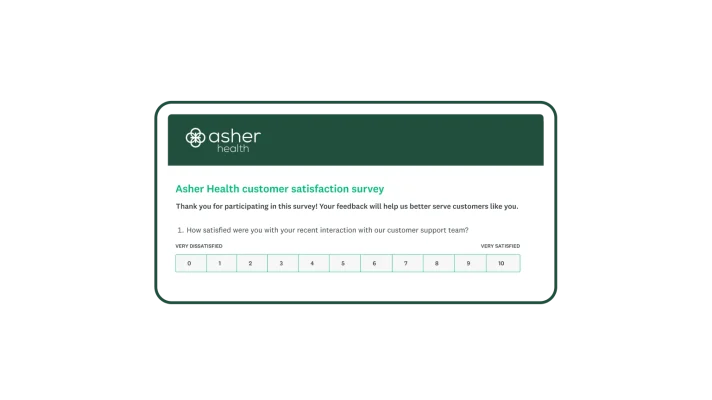
- The CSAT score is crucial as it directly gauges customer satisfaction, helping businesses to enhance their offerings, improve customer loyalty and maintain a positive brand reputation.
- A good CSAT score typically ranges from 70% to 85%, indicating strong customer satisfaction, although the ideal score can vary from one industry to another.
- To improve your CSAT score, you should focus on addressing customer feedback, enhancing service quality and streamlining processes to meet customer needs and expectations more effectively.
Customer satisfaction (CSAT) is a crucial measure of how well a company meets or exceeds customer expectations.
High satisfaction levels are a strong indicator of business success, as satisfied customers are more likely to return and recommend the brand to others. Focusing on customer satisfaction helps you build loyalty and drive long-term growth.
Monitoring your customer satisfaction score is the first step towards increasing or maintaining a good score.
This article explains how to calculate and improve your CSAT score and defines what is considered a good score.
Customer satisfaction (CSAT) score: A brief overview
What is CSAT?
CSAT is a customer experience (CX) metric that measures how customers feel about your business. CSAT surveys help you to build customer loyalty, increase retention rates and uphold a strong brand reputation.
CSAT scales, which are typically 1–5 or 1–10, reflect customer satisfaction with your products or services. This metric provides a clear overview of how customers perceive your business.
CSAT surveys often include a question, such as “Please rate your overall satisfaction with [company] from 1 to 5.” Customers select a number that represents their level of satisfaction.
How CSAT scores are calculated
Calculating your CSAT score based on the survey results involves a straightforward formula.

To calculate your CSAT score, you need to know the number of satisfied customers and the total number of responses. The customer satisfaction formula is as follows:
(Number of satisfied customers / Total number of responses) x 100 = % of satisfied customers
For example, if you received 75 satisfied responses out of 100 respondents, 75% of customers were satisfied.
What is a good CSAT score?
Determining whether your CSAT score is good is more nuanced than it seems. Although typical ranges exist, the true measure comes from benchmarking your results against those of your industry peers.
A CSAT score that is considered ‘good’ generally falls between 70% and 85%. Here are typical ranges, excluding industry-specific data.
CSAT score ranges:
- 0–50% = Requires improvement
- 50–70% = Fair
- 70–85%= Good
- 85–100% = Excellent
Interpreting your CSAT score
CSAT surveys typically use a 1–5, 1–7 or 1–10 scale, where 1 represents the worst score and 10 the best. Use these models to interpret your scores.
On a scale of 1 to 5:
1 - Very unsatisfied
2 - Unsatisfied
3 - Neutral
4 - Satisfied
5 - Very satisfied
On a scale of 1 to 7:
1 - Extremely unsatisfied
2 - Very unsatisfied
3 - Unsatisfied
4 - Neutral
5 - Satisfied
6 - Very satisfied
7 - Extremely satisfied
On a scale of 1 to 10:
1 - Extremely unsatisfied
2 - Very unsatisfied
3 - Unsatisfied
4 - Quite unsatisfied
5 - Neutral
6 - Quite satisfied
7 - Satisfied
8 - Very satisfied
9 - Extremely satisfied
10 - Perfectly satisfied
The ‘satisfied’ or ‘good’ scores are as follows:
- On a scale of 1 to 5: 4 and 5
- On a scale of 1 to 7: 5, 6 and 7
- On a scale of 1 to 10: 6, 7, 8, 9 and 10
It’s difficult to achieve a perfect score, but you can monitor customer satisfaction and make improvements based on customer feedback to turn detractors into promoters.
Abercrombie & Fitch improved its CSAT score by 40% by implementing a strategic initiative in 2017 which focused on personalising the in-store shopping experience. The company enhanced service quality by training associates to leverage customer data, such as purchase history and style preferences, thus boosting customer satisfaction and loyalty.
Costco achieved an impressive 85% CSAT score, surpassing the industry benchmark of 79%. The company’s success is attributed to its membership programme and focus on value-based, high-volume sales. Costco’s 92.6% membership renewal rate in the U.S. and Canada reflects its particularly strong customer loyalty there and contributes to its high CSAT score.
What is a good CSAT score for each industry?
Customer satisfaction scores and benchmarks vary from one industry to another, reflecting differing expectations. The UK Customer Satisfaction Index (UKCSI) provides industry-specific CSAT benchmarks, which we will use for this comparison.
Retail and e-commerce CSAT scores
Retail and e-commerce CSAT benchmarks typically range from the 70s to the 80s. Managing customer expectations, especially for online shoppers, is crucial. During the 2020 pandemic, online retailers saw the largest decline in customer satisfaction across all retail categories as they struggled to meet demand.
Here are some good CSAT scores for the retail and e-commerce industry:
Healthcare CSAT scores

Healthcare CSAT scores range from the 60s to the 80s. Timely and compassionate care is crucial to the patient experience and directly influences satisfaction.
Here are some optimal healthcare CSAT scores:
- Non-hospital care: 81%
- Hospitals: 74%
- Outpatient care: 81%
- Inpatient care: 72%
- A&E: 67%
Financial services CSAT scores
In the finance sector, a strong CSAT score is around 80, which is slightly higher than in some other industries we’ll review.
Here are some good customer satisfaction benchmarking scores:
- Financial advisors: 80%
- Credit unions: 79%
- Banks: 80%
- Local and community banks: 82%
- National banks: 80%
- Super-regional banks: 77%
- Online investment: 79%
SaaS CSAT scores
CSAT scores are critical to success in the SaaS industry, with companies like Google and Amazon Prime Video emphasising high customer satisfaction.
Here are some good SaaS CSAT scores:
Education CSAT scores
According to Gallup, K-12 education satisfaction in the U.S. reached an all-time low of 36%. In 2023, K-12 education satisfaction in the U.S. was nine points below the historical average of 45%. This is probably due to the increase in teacher departures and the shortage of qualified educators in the U.S.
How to improve your CSAT score
To improve your business’s CSAT score, you should focus on putting the customer at the centre of your operations. You should ensure top-quality products and services as well as invest in customer interaction and support services training.
Collect and act on customer feedback
The first step is to gather detailed customer feedback by means of comprehensive and targeted surveys. These surveys provide more in-depth insights than standard CSAT surveys. Consider including survey questions such as:
- What can our company do to meet your needs more effectively?
- What value do we provide?
- What are your biggest challenges?
- Why did you choose us instead of one of our competitors?
The feedback obtained from these questions will guide your business’s growth strategy and enhance customer service.
Address customer pain points
A critical step that is often overlooked is acting on customer feedback. Although collecting and analysing feedback is certainly valuable, meaningful improvements require action based on the insights and responses received.
After gathering feedback, identify and analyse key issues, such as inconsistent product quality, long waiting times or shipping delays. Determine which pain points are relevant to your brand and implement strategies to address them. These improvements are essential for increasing customer satisfaction.
Improve customer interactions
Enhancing customer interactions, both in-store and online, will have a significant impact on overall satisfaction. Interactions with your staff can profoundly influence a customer’s experience with your brand. Every interaction, regardless of its scale, is important.
Ensure that every customer feels valued as if it were their first visit. Monitor customer experience metrics over time to gauge improvements in your business’s interactions.
In-store
To enhance in-store customer interactions, you should train employees to deliver positive and personalised experiences. Although it may take some time to see the results, personalisation – as seen with Abercrombie & Fitch – can significantly boost satisfaction.
Consider the following factors for improving in-store experiences:
- The checkout process. Is the checkout process smooth or do customers experience long delays? In the latter case, you should identify any bottlenecks and streamline the process. Consider hiring additional staff, updating the point-of-sale system or adjusting the rewards programme sign-up process.
- Customer service waiting times. Ensure that customers can easily find employees on the sales floor without having to queue. Train staff to assist promptly and resolve issues efficiently to optimise customer service.
- Ease of finding prices. If customers struggle to find item prices, this can lead to frustration and decreased satisfaction. Ensure that all merchandise is clearly and accurately priced to avoid confusion.
- Cost compared to competitors. Consider how your product pricing compares to that of your competitors. If your products are more expensive, ensure that the added value is clear to consumers so they understand that, even though your products are not the cheapest, they are the best choice.
- Shop/store organisation. The physical design and organisation of your shop/store are crucial to the customer experience. Ensure that your products are organised and displayed logically so customers can easily find what they need without frustration.
Online
Online customer experiences are different from in-store experiences in many ways. Online retailers can focus on the customer experience by evaluating their website’s usability, competitors’ policies and prices, and support teams.
- Site navigation. Effective site navigation is crucial for the user experience. Evaluate your website’s performance and ease of use. Ensure that site navigation is well defined and organised, with an intuitive menu for first-time visitors.
- Return policy. Evaluate whether your return policy matches that of your competitors and ensures customer satisfaction. A cumbersome return process can drive customers to other retailers. Ensure that returns and exchanges are as seamless as possible.
- Shipping times/prices. Assess whether customers frequently complain about shipping times or prices and how they compare to industry standards. Address any shipping delays and explore ways to prevent them. Consider offering free shipping if your competitors do, as this can enhance customer satisfaction and boost sales.
- Variety of products. Is the product selection of your shop/store sufficient to meet your customers’ needs? Are there any additional products that they would like you to stock? Gather customer feedback to assess whether expanding your product range would enhance satisfaction.
- Customer support. Online customer support is a critical area where companies should invest time and resources. A customer’s interaction with a support representative significantly affects their overall perception of your company. A single poor experience can have a significant impact on loyalty, necessitating investment in comprehensive training for your support team.
Boost customer service quality
Boosting customer service quality can increase your CSAT score, so customer service should be at the top of your list for improvements.
There are several ways to help improve your company’s customer service quality, including:
- Training staff. Provide staff training on best practices for customer service in the form of comprehensive onboarding and ongoing education. Ensure that representatives are suitably equipped to resolve common issues promptly and provide clear instructions.
- Streamlining communication channels. Ensure that customer service chat options or forms are easily accessible on your website. Streamline access by prominently displaying the customer service portal so that customers can find it easily.
- Reducing customer effort. Do you know your customer effort score (CES)? CES surveys assess the ease of completing a task and measure the effort that a customer exerts to resolve an issue. This score highlights any potential pain points in the customer journey, allowing you to reduce friction and improve satisfaction.
Build a customer-centric culture
A customer-centric culture enhances loyalty and satisfaction. To build this culture, focus on delivering positive experiences at every touchpoint. Ensure that every business decision considers the customer impact. Here are two steps you can take to foster a customer-centric culture:
- Foster open communication. Encourage open communication with customers by means of feedback and experience surveys. Make it clear that their input is valued and welcomed, allowing them to share their experiences and suggestions for improvement.
- Encourage employee feedback and suggestions. Employees can provide valuable insights into enhancing the customer experience. Encourage their feedback through open discussions, one-on-one meetings, employee surveys or suggestion boxes.
Get started with SurveyMonkey today
A good CSAT score generally ranges from 70% to 85%, although this varies from one industry to another and according to the sample size. It is crucial to measure customer satisfaction and gather feedback to enhance the customer experience.
Refer to industry benchmarks when interpreting your CSAT score and prioritise continuous improvement to boost customer loyalty and attract new markets.
To collect customer feedback, use SurveyMonkey’s CSAT surveys and other tools. Get started today to access our free survey templates.
Discover more resources

Solutions for your role
SurveyMonkey can help you do your job better. Discover how to make a bigger impact with winning strategies, products, experiences and more.

Hornblower enhances global customer experiences
Discover how Hornblower uses SurveyMonkey and powerful AI to make the most of NPS data, collect customer insights and improve customer experiences.

Ultimate customer satisfaction guide: 8 tactics for improvement
What is customer satisfaction? Read our complete guide to discover what customer satisfaction is, how to measure it and eight strategies for business success.

A Guide to the Customer Effort Score (CES): What It Is and How to Use It
Learn how to measure customer satisfaction and experience using the customer effort score (CES). This guide explains what you need to know.